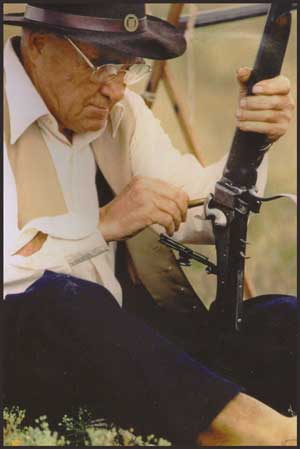Austin had a lifelong passion for guns. He grew up on a ranch in northwest Montana and guns were a necessary tool for Montanans back then. There were gophers and coyotes to shoot, not to mention wild game and fowl for the table.
A Gun and It's Story

Sharps Model 74 Caliber 45 2 7/8
This is by far the heaviest of Austin's Sharps. The barrel is 30 inches long and about 1 1/4 inch in diameter. It weighs a little over 15 pounds. Austin told me that this barrel had to be so heavy because it was intended for mass slaughter of buffalo. The thickness would help keep it from getting too hot and warping from shooting buffalo after buffalo. The barrel is marked Old Reliable Sharps Rifle Bridgeport Conn on the top with the number 45. It is also marked 45 under the forearm. It is stamped, "Sharps Rifle Co PAT Apr 6 1869" on the receiver. The serial number is 157075 and is stamped on the tang but under the rear sight.
He bought the gun in 1935 for $50 in a Seattle pawn shop. He said, "I worried for three or four days about spending the $50 before going out and buying it." He was 22 at the time and was running a dragline in the Seattle harbor and staying in one of the old seedy hotels along Skid Row that had fallen from its days of glory at the turn of the century. When he brought the gun into the hotel, he tried to be discreet by carrying it up to his room wrapped in his old overcoat. He almost made it to the top when the gun slipped out of the coat and clattered all the way down the big marble staircase. He said it made a heck of a noise but didn't get hurt. Oops!
This is the gun he used to win the Virginia City buffalo shoots. He won the trophy twice, once in 1982 and again in 1986. He was 73 in 1986, probably 25 years older than the average shooter there. After losing the trophy the first time when he was 70, he thought he should get glasses. He went to the eye doctor and had him make a special pair of bifocals. The bifocal was not down at the bottom of the glass where we're used to seeing them. It was a round spot in the upper inside corner so he could see through it when he was aiming. I think he told the eye doctor that he wanted it to be set to see something 1,000 yards away.



